Ballyhillion, Malin Head, County Donegal, Monday evening, 17 July:
Today we visited Derry, and then after dinner back here I took a spectacular solo tramp round Malin Head.
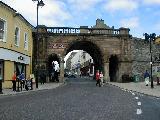
 In Derry, aka (among Unionists) Londonderry, we found a city that seemed strangely stuck in and on the seventeenth century. We entered the older walled section of the city through Ferryquay Gate (left), where we returned (after lunch and a futile attempt to upload the previous journal entry) to start our walking tour of the walls.
In Derry, aka (among Unionists) Londonderry, we found a city that seemed strangely stuck in and on the seventeenth century. We entered the older walled section of the city through Ferryquay Gate (left), where we returned (after lunch and a futile attempt to upload the previous journal entry) to start our walking tour of the walls.
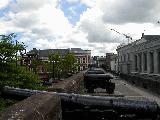
 These famous, intact, and never breached city walls date from the aforementioned century. So does St. Columb's cathedral, Western Europe's first originally Protestant (though presumably very High Church) cathedral; and so too do most of these cannon, unaccountably trained on the neo-Gothic Guildhall (itself shown at right, along with Magazine Gate, a Palladian bank, and a corner of the Tower Museum.)
These famous, intact, and never breached city walls date from the aforementioned century. So does St. Columb's cathedral, Western Europe's first originally Protestant (though presumably very High Church) cathedral; and so too do most of these cannon, unaccountably trained on the neo-Gothic Guildhall (itself shown at right, along with Magazine Gate, a Palladian bank, and a corner of the Tower Museum.)
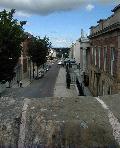
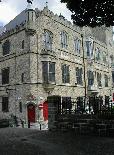 Outside these walls, the buildings are almost entirely twentieth century, at least partly because so many have been bombed. What is peculiarly striking, however, is how the city's notorious sectarian passions still focus on events of the seventeenth century. Just as the Orange Order marches throughout Northern Ireland on 12 July commemorate the 1690 Battle of the Boyne, so too Derry's very own contentious ritual a month later, the Apprentice Boys' parade on the city walls, commemorates the original Apprentice Boys' gallantry and determination in the Protestant Whig cause during the 1689 siege of Derry. Moreover, the explanatory placards posted at various points around the walls had met with oddly antiquarian vandalism: the face of Catholic King James II, whose portrait served to illustrate a placard at Bishops Gate (from which gate the photo on left was taken), had been attacked and largely obliterated, apparently with burning cigarettes, and presumably by Protestant Unionists; while any portraits of the city's Protestant defenders against King James's siege had been similarly attacked, presumably by Catholic Nationalists, along with any occurrences of the "London" part of the city's name. On the section of the walls facing the Catholic Bogside neighborhood stands a large marble platform that once supported a column with statue, memorializing one of the defenders in that siege; but the column was gelignited by the IRA in 1973. Near that same point along the circuit, the Apprentice Boys' Memorial Hall (right) overlooks Bogside from within the walls.
Outside these walls, the buildings are almost entirely twentieth century, at least partly because so many have been bombed. What is peculiarly striking, however, is how the city's notorious sectarian passions still focus on events of the seventeenth century. Just as the Orange Order marches throughout Northern Ireland on 12 July commemorate the 1690 Battle of the Boyne, so too Derry's very own contentious ritual a month later, the Apprentice Boys' parade on the city walls, commemorates the original Apprentice Boys' gallantry and determination in the Protestant Whig cause during the 1689 siege of Derry. Moreover, the explanatory placards posted at various points around the walls had met with oddly antiquarian vandalism: the face of Catholic King James II, whose portrait served to illustrate a placard at Bishops Gate (from which gate the photo on left was taken), had been attacked and largely obliterated, apparently with burning cigarettes, and presumably by Protestant Unionists; while any portraits of the city's Protestant defenders against King James's siege had been similarly attacked, presumably by Catholic Nationalists, along with any occurrences of the "London" part of the city's name. On the section of the walls facing the Catholic Bogside neighborhood stands a large marble platform that once supported a column with statue, memorializing one of the defenders in that siege; but the column was gelignited by the IRA in 1973. Near that same point along the circuit, the Apprentice Boys' Memorial Hall (right) overlooks Bogside from within the walls.
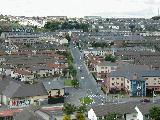
 Bogside, for its part, directs upward at the walls the reproachful murals shown on left (including the figure of a Catholic schoolgirl shot dead in the Troubles), and the more defiant one shown on right, showing Bernadette Devlin in her heyday with jeans and bullhorn. The mural says "You are now entering Free Derry," in reference to a late-sixties agreement that the Royal Ulster Constabulary, having been violent towards Catholic protesters, would henceforth stay out of that neighborhood.
Bogside, for its part, directs upward at the walls the reproachful murals shown on left (including the figure of a Catholic schoolgirl shot dead in the Troubles), and the more defiant one shown on right, showing Bernadette Devlin in her heyday with jeans and bullhorn. The mural says "You are now entering Free Derry," in reference to a late-sixties agreement that the Royal Ulster Constabulary, having been violent towards Catholic protesters, would henceforth stay out of that neighborhood.
Depite all its troubles, we found Derry extremely attractive and its people extraordinarily kind and helpful to us.
My after-dinner tramp round the cliff-top foot-paths of Malin Head was a high point to an already good day--for me, indeed, it was the high point of the whole trip so far. I do not think I have ever seen finer scenery. At times I had to think and step like a mountain goat (particularly to get some of these photos), while at other times I could freely go any direction across close-cropped pasture.
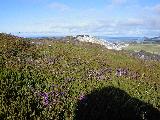





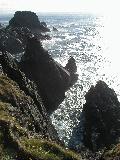
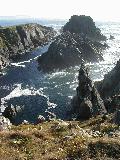
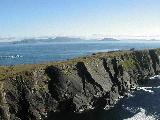
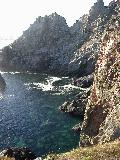


previous entry
next entry
main/ToC page

 In Derry, aka (among Unionists) Londonderry, we found a city that seemed strangely stuck in and on the seventeenth century. We entered the older walled section of the city through Ferryquay Gate (left), where we returned (after lunch and a futile attempt to upload the previous journal entry) to start our walking tour of the walls.
In Derry, aka (among Unionists) Londonderry, we found a city that seemed strangely stuck in and on the seventeenth century. We entered the older walled section of the city through Ferryquay Gate (left), where we returned (after lunch and a futile attempt to upload the previous journal entry) to start our walking tour of the walls.

















